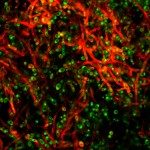Link to Pubmed [PMID] – 18845828
J. Clin. Microbiol. 2008 Nov;46(11):3772-7
Detection of galactomannan antigen (GMA) in serum is the standard assay for the diagnosis of invasive aspergillosis (IA) in high-risk patients with hematological disorders. Detection of Aspergillus DNA in serum has been proposed, but its sensitivity is lower than that of GMA when small serum volumes (SSV) are used. In this study, we investigated whether extraction of DNA from large serum volumes (LSV) improves diagnostic yield. In a 13-month prospective study, we compared the performances of twice-weekly screening of serum for GMA by an enzyme immunoassay and weekly screening for Aspergillus fumigatus DNA by a real-time PCR (RT-PCR) assay of 1.0 ml (LSV) or 100 mul (SSV) of serum. We included 124 patients (138 treatment episodes), with 17 episodes of EORTC (European Organization for Research and Treatment of Cancer)/MSG (Mycoses Study Group)-documented IA. In all, 1,870 samples were screened for GMA. The sensitivity (Se), specificity (Sp), and positive and negative predictive values (PPV and NPV, respectively) of GMA for IA were 88.2%, 95.8%, 75%, and 98.3%, respectively. We screened 938 samples for Aspergillus DNA by using LSV; 404 of these samples were also tested with SSV. The Se, Sp, PPV, and NPV of RT-PCR were 100%, 96.7%, 81%, and 100%, respectively, with LSV and 76.5%, 96.7%, 81.3%, and 95.6%, respectively, with SSV. DNA detection gave a positive result when performed on LSV in two cases of IA where the GMA assay result remained negative. Furthermore, in four IA cases, DNA was detected earlier than GMA. The use of LSV for extraction improved the performance of the RT-PCR, which appears highly sensitive and specific for the early diagnosis of IA in high-risk patients with hematological disorders.

